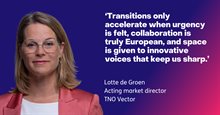Curious about the report?
Using captured CO2 as a sustainable fuel for heavy transport
‘Capturing CO2 from fossil point sources, such as a coal-fired power plant or a steel mill, not only ensures that less of this greenhouse gas is released into the atmosphere, but that the captured CO2 is also well suited for the production of e-fuels’, Karin van Kranenburg starts explaining.
As a senior consultant at TNO Vector, she focuses on strategic innovation issues. She is particularly concerned with the transition to sustainable hydrogen, fuels, and chemistry. And she stresses that e-fuels are expected to play a key role in making long-distance heavy transport more sustainable, such as with aircraft, international freight, and seagoing vessels.
Using captured fossil CO2 to make fuels: not everyone is enthusiastic about this. After all, won’t that just perpetuate current fossil fuel-based systems unnecessarily?
‘Capturing fossil CO2 is indeed a sensitive issue’, Van Kranenburg knows. ‘Because it can be very tempting for companies to store captured CO2 underground or use it to produce e-fuels and neglect working on sustainable solutions for a fossil-free future.’
Different scenarios for e-fuels for heavy transport
‘If you use wind and solar energy to power electric cars today, you can achieve a much greater CO2 reduction than if you use that electricity to produce green hydrogen and then use it to produce e-fuels’, Van Kranenburg points out. ‘Besides, producing e-fuels is very expensive. It is also more expensive than biofuels.
But if you look at the longer term, biomass is expected to be available to make some of the long-distance heavy transport more sustainable, but not all of it. And because batteries are heavy and have limited capacity and power, electrification is not an option for this type of transport, and certainly not for shipping and aviation.
The way it looks now, the use of e-fuels will be a necessary option in the future. At least, that was our assumption. And by working out different options, juxtaposing both fossil fuel and e-fuels situations, we can now compare different scenarios on key points.’
Objective, fair comparisons
Selecting the scenarios to run was not so easy. Van Kranenburg: ‘We started with as many as 11 different configurations. That was too many, so we reduced that number to 5.
The next challenge was to do the comparisons in an objective and fair way. Several TNO experts contributed to the process. For example, we received advice from a colleague who knows the costs of making molecules in the chemical industry. And it was also incredible to be able to consult with a colleague who knows a lot about CO2 capture and underground storage, and a colleague who specialises in making the transport sector more sustainable. Many internal discussions were needed. ‘Not only to determine what the key options are, but also to agree exactly on what we should include in the configurations and why.’
CO2 emissions from an aircraft: 5 configurations
All configurations calculated considered an aircraft burning one gigajoule of kerosene. Producing that kerosene requires 0.09 tonnes of CO2. These (1 GJ and 0.09 tCO2) are therefore the baseline values. In addition, a fossil point source is present, emitting 0.09 tCO2. This involves the following five configurations:
- Flying with fossil kerosene, releasing CO2 into the atmosphere.
- Flying with fossil kerosene, capturing the CO2 at the point source, and then storing it underground (CSS).
- Flying with e-kerosene made from CO2 captured at the point source (CCU).
- Flying with fossil kerosene, releasing the CO2 into the atmosphere in the process but offsetting it with Direct Air Capture (DAC), a technology that removes CO2 from the atmosphere and then stores it underground.
- Flying with e-kerosene made from atmospheric CO2 (DAC) and releasing the CO2 into the atmosphere.
E-fuels from captured CO2 at point source is the best temporary solution?
‘As expected, the scenario where CO2 from the atmosphere is used to produce e-fuels (DAC) is the most sustainable option. Configuration 5, then’, Van Kranenburg summarises the equation briefly. ‘But this technology is still so expensive that it only becomes interesting at an ETS price of more than €700 per tonne of CO2.
By comparison, the ETS price is currently around €80 per tonne. At present, there is no point in removing CO2 from the atmosphere on a large scale because there are still many fossil point sources where CO2 can be captured directly.
By capturing that CO2, a significant reduction in CO2 emissions can already be achieved in the short term. But we obviously want to get rid of these fossil point sources, which means that Configuration 3 has to be a temporary solution. And this is exactly the aim of the new EU regulations, which stipulate that e-fuels using CCU will be classified as RFNBO (Renewable Fuels of Non-Biological Origin) until 2040.’
‘Good news’, thinks Van Kranenburg. ‘Indeed, these new regulations will make e-fuels more attractive in the short term. And this is without removing any incentive for further sustainability, because after 2040, of the above options, only Option 5 (DAC) will be classified as RFNBO. And if all goes well, the recently introduced EU regulations will have led to a viable e-fuels market by then.’
Discussion on the sustainability of e-fuels now with substantiated figures
TNO Vector’s specialists are very good at analysing costs and looking at the big picture, while taking into account the implications of existing and potential new regulations.
‘This is important, because regulations are often the main driver for sustainability anyway’, Van Kranenburg points out. ‘The new EU regulation on e-fuels is a good example. In the meantime, we will of course continue to monitor developments closely. It is very important that we can now discuss e-fuels and CO2 capture with solid figures.’
Questions? Get in touch with us





